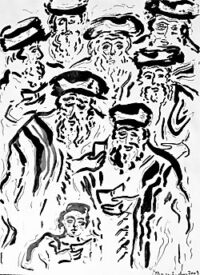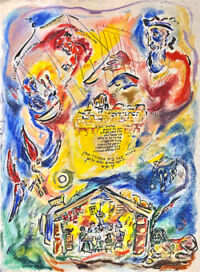AGJA Blog Archives
Swinging chickens.
In a few days we celebrate Yom Kippur.
It is a day of repentance, forgiveness, and atonement, many people fast, go the synagogue, and reflect on their life and their relationship with other people and with G-d. Before Yom Kippur, we ask those we know for forgiveness for intended and unintentional offenses and wrong doings. To ask people we don’t like (or worse) is more difficult, but we make every effort to enter Yom Kippur with a clean slate.
read more
An artist’s challenge: how to paint a Trial with G’d?
Dear fellow artists and art lovers,
In the past, I have posted an article about Rabbi Aryeh-Leib, aka the Shpoler Zeida (Grandfather from Shpola), a Chassidic Master who lived in the Ukraine from 1724-1811.
In the year 1780, a terrible famine struck the Ukraine, making the lives of its Jewish inhabitants even more miserable than they were already due to antisemitism, pogroms, a horrible bureaucracy, bad winters, and grinding poverty.
read more
A message from the president:
According to our tradition, G-d created the world with Ten Words. These are the ten times G-d spoke, as described in the first chapter of the Torah, and as a result the world got created, expanded, improved with new features and creatures, embellished and refined. And at the end of each of the six days of creation “G-d saw that it was good”. On the seventh day weshabat mikol melakhto asher bara El-him la’asot, and He rested from all the work which Elohim had created to make.
read more
Me-avdut la-cherut. From slavery to freedom. Counting the Omer and the journey to Har Sinai.
In my last column I talked about my Pesach haggadah, but now we are in a different stage of the story. We left Egypt, crossed the sea, and are in the desert on our way to Mount Sinai. There we will receive the G-d’s Torah from the hands of Moshe Rabbenu. But in order to shed our slave mentality from Egypt we have to wait 49 days—that is 7 weekstill the Festival of Weeks, Shavuot. Every day we count the Omer (Sefirat ha-Omer) for 49 times until we are ready to exclaim as free people at har Sinai: “We will do and we will hear.”
read more
Birkat Habayit, a Blessing for the House
Most of us are familiar with the Blessing of the House, a Hebrew blessing for peace and prosperity for the inhabitants of a house. It is usually painted, written, calligraphed, printed, sculpted, engraved, embroidered or woven, accompanied by decorative borders or art work, on metal, paper, leather, material, canvas, tiles, clay, wool, and the like. A beloved theme for these blessings is a picture of Jerusalem. Sephardic versions are often shaped like a chamsa, a hand, to ward off the evil eye, and many have a box filled with tiny blue stones.
read more
Fleeting memories and loneliness.
Many artists travel to get inspiration. Some move their studio from city to city, from place to place to find new artistic perspectives, new galleries, an inspiring new environment, or new love. And some don’t. I mention two of my favorite artists who had very different lives. Rembrandt, who was born in Leyden (Holland), moved to nearby Amsterdam and stayed there until death took the brush from his hands.
read more
G-tt fun Avrohom. A Yiddish prayer for Havdalah
The language that Jews all over the world have in common when they pray is Hebrew, the ancient language of our people from biblical times. It has been revived as an everyday language in the twentieth century in our country, Israel. But it is inevitable, that Jews living outside of Israel have been influenced by the culture and languages of the countries where we landed during our long Diaspora, which started two millennia ago.
read more
The dream of the kabbalist. Would this be any different in better times?
Last winter, I was in Jerusalem, planning to go to the North to visit the mystical city of Tzfat with its 15 th -century Abuhav Synagogue, one of the most beautiful and spiritual places I know of, and the nearby hill-slope cemetery with the cerulean blue gravesites of revered kabbalists, like the Arizal, the Holy Lion. I hadn’t been there in over thirty years. I never made it, though, because of an unexpected phone call that came from Holland: my mother had suddenly fallen critically ill.
read more
A Family History 1. The Left Panel: Israel and Canada
Last week I spoke about the family history of the Kadish-Epsteins and discussed the panel on the right side, of Eastern Europe and South Africa. Now we look at the panel on the left side with Israel and Canada. How are these two very different countries connected in one drawing?
read more
Portraits by Shoshannah Brombacher, PhD, Part 2
Shoshannah Brombacher paints her portraits with many of the ideas discussed in the first part if this blog in mind. Let’s look at her approach with some samples.
1. The lovers was made in the early years after her marriage, which brought her from the academic world of Berlin to the (Lower) Eastside of New York. Moving to America had a deep impact.
read more
A Family History 2. The Right Panel: Eastern Europe and South Africa
In my last AGJA blog about portraits I mentioned a Canadian family which commissioned me to depict their family history, originating in Eastern Europe and fanning out via South Africa to Israel and the New World, a typical Jewish journey. They handed me all the information they had, old papers, part of a family trees, family stories, and even some photographs.
read more
A story includes a painting, but how do you proceed?
Every painter chooses different themes and subjects and has a different modus operandi. I have always been a story teller, long before I got officially ordained as a maggidah in New York in 2009. Already as a child I loved to paint my stories. I usually make a couple of drawings to depict a narrative. Sometimes only one is sufficient. But how does an artist select that one scene in the story? It must be catching and at the same time represent the essence, the message.
read more
Tisha BeAv
We are “in the nine days” preceding Tisha BeAv, which commemorates the two times in history that Jerusalem and the Temple were destroyed—the first time by the Babylonians in 586 BCE and the second time by the Romans in 70 CE. After the first destruction, ten of the twelve Jewish Tribes were exiled from the Northern Kingdom of Israel.
read more
Whose memories are they?
Many artists draw inspiration from their memories. They paint, write, sculpt, sing, quilt, compose, or use any other media to depict scenes form their childhood, their lives, and their loves. Marc Chagall (1887-1985), the face of Jewish art in the twentieth century, left his family near Vitebsk in Russia to familiarize himself with modern western art in Paris.
read more
This is how our forefathers danced.
Today is Lag Baomer, a Jewish holiday in the middle of the period of mourning between Pesach and Shavuot, when all kind of disasters befell the Jewish people, in different times and places. We celebrate today that the plague epidemic which hit the students of Rabbi Akiva stopped on the thirty-third day of the Omer.
read more
The Fifty Gates
The Chassidic Jews of Eastern Europe loved to tell stories. Many anecdotes about their Rebbes (rabbis, or spiritual leaders) contained profound spiritual, allegorical and philosophical truths, hidden in layers of simple folk tales. A good example is the story of Rabbi Barukh of Medzhibuzh (1757-1811), the grandson of the founder of the Chassidic movement, Rabbi Israel Baal Shem Tov.
read more
To create a Haggadah
Why is this holiday different from all other holidays? Or: the dilemma of creating Pesach art before Pesach. Right after Purim most Orthodox Jews get nervous: it’s exactly one month till Pesach and that means cleaning, organizing, sorting out stuff, remembering where the boxes with Pesachdike pots and plates are—the benefit of finding things you lost back doesn’t outweigh the trouble and aggravation, though—and in my case also moving lots of things around in a small, overcrowded New York apartment.
read more

















